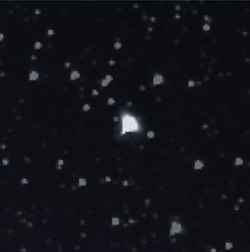| Observation data Epoch J2000 Equinox J2000 | |
|---|---|
| Constellation | Reticulum |
| Right ascension | 03h 26m 59.22s[1] |
| Declination | −63° 29′ 56.9″[1] |
| Apparent magnitude (V) | 8.143[2] |
| Characteristics | |
| Spectral type | K4.5V[3] |
| U−B color index | 1.144[2] |
| B−V color index | 1.159[2] |
| Astrometry | |
| Radial velocity (Rv) | 59.32±0.12[1] km/s |
| Proper motion (μ) | RA: 355.20[1] mas/yr Dec.: -247.39[1] mas/yr |
| Parallax (π) | 61.2271 ± 0.0150 mas[1] |
| Distance | 53.27 ± 0.01 ly (16.333 ± 0.004 pc) |
| Absolute magnitude (MV) | 6.95[4] |
| Details[5] | |
| Mass | 0.73±0.07 M☉ |
| Radius | 0.695±0.030 R☉ |
| Luminosity | 0.20597±0.00016 L☉ |
| Surface gravity (log g) | 4.613+0.052 −0.061 cgs |
| Temperature | 4640±100 K |
| Metallicity [Fe/H] | 0.003±0.060 dex |
| Rotation | 34.1+2.4 −2.7 d[6] |
| Rotational velocity (v sin i) | 1.04 km/s |
| Age | 3.8±3.7 Gyr |
| Other designations | |
| Database references | |
| SIMBAD | data |
HD 21749 is an orange main-sequence star in the constellation Reticulum. It has an apparent visual magnitude of 8.143, which means it is too dim to be seen with the naked eye. From parallax measurements by the Gaia spacecraft, it is located 53 ly (16 pc) from Earth.
In 2019, it was discovered that the star has two exoplanets: a possibly rocky, hot sub-Neptune-sized exoplanet named HD 21749 b; and an Earth-sized exoplanet named HD 21749 c. These exoplanets were discovered by the TESS spacecraft.
- ^ a b c d e f Cite error: The named reference
gaiadr3was invoked but never defined (see the help page). - ^ a b c Cite error: The named reference
koen2010was invoked but never defined (see the help page). - ^ Cite error: The named reference
Gray2006was invoked but never defined (see the help page). - ^ Cite error: The named reference
xhipwas invoked but never defined (see the help page). - ^ Cite error: The named reference
Dragomir2019was invoked but never defined (see the help page). - ^ Cite error: The named reference
Gan2021was invoked but never defined (see the help page). - ^ Cite error: The named reference
SIMBADwas invoked but never defined (see the help page).
